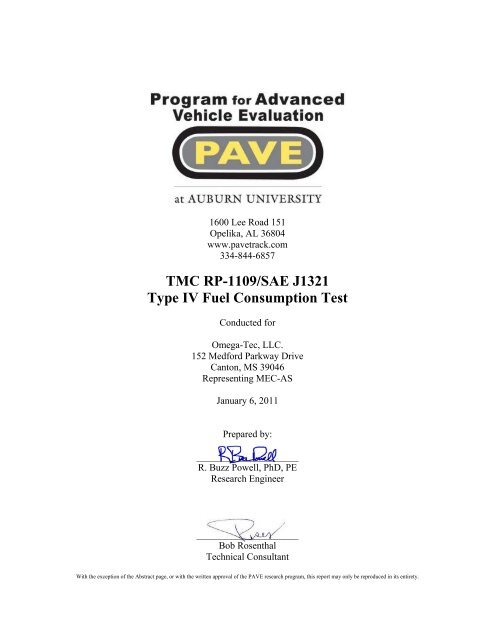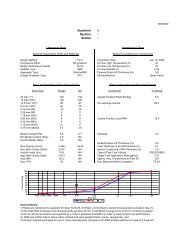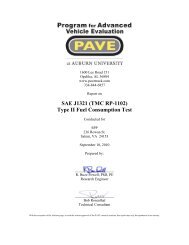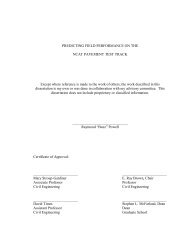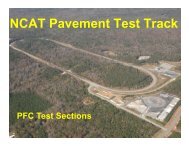TMC RP-1109/SAE J1321 Type IV Fuel Consumption Test - pavetrack
TMC RP-1109/SAE J1321 Type IV Fuel Consumption Test - pavetrack
TMC RP-1109/SAE J1321 Type IV Fuel Consumption Test - pavetrack
You also want an ePaper? Increase the reach of your titles
YUMPU automatically turns print PDFs into web optimized ePapers that Google loves.
11600 Lee Road 151Opelika, AL 36804www.<strong>pavetrack</strong>.com334-844-6857<strong>TMC</strong> <strong>RP</strong>-<strong>1109</strong>/<strong>SAE</strong> <strong>J1321</strong><strong>Type</strong> <strong>IV</strong> <strong>Fuel</strong> <strong>Consumption</strong> <strong>Test</strong>Conducted forOmega-Tec, LLC.152 Medford Parkway DriveCanton, MS 39046Representing MEC-ASJanuary 6, 2011Prepared by:_____________________R. Buzz Powell, PhD, PEResearch Engineer_____________________Bob RosenthalTechnical ConsultantWith the exception of the Abstract page, or with the written approval of the PAVE research program, this report may only be reproduced in its entirety.
1ABSTRACTThe Program for Advanced Vehicle Evaluation (PAVE) was established at Auburn University as acomplementary research program at the National Center for Asphalt Technology’s (NCAT) Pavement <strong>Test</strong>Track (www.<strong>pavetrack</strong>.com). In order to damage experimental pavements on the 1.7-mile test oval, it isnecessary to run a fleet of heavy trucks over ¾ million miles a year. Trucking operations at the Track andthe close proximity to federal and interstate highways provide a unique opportunity to study issues that areimportant to the trucking industry in a highly controlled and cost effective manner. The purpose of theevaluation described herein was to determine the impact of the Omega-Tec (Molecular <strong>Fuel</strong> Economizer,U.S. Patent 7,650,877) product on fuel economy when used on the 14L diesel engine of class 8 tractors.This technology is developed, produced, and owned by Magnetic Emission Control AS, Norway (MEC-AS). In America, Omega-Tec, LLC is the exclusive distributer of the product on behalf of MEC-AS.In this evaluation, fuel usage in a test vehicle was measured with and without the Molecular <strong>Fuel</strong>Economizer installed in both the fuel and air inlet systems. A second similar tractor/trailer combinationwas used as a control vehicle. The test plan for the evaluation included a baseline segment and a testsegment. Although this was an on-highway test, the fueling station and all necessary equipment werestationed at the NCAT Pavement <strong>Test</strong> Track and operated by Track personnel.The “<strong>Type</strong> <strong>IV</strong> <strong>Fuel</strong> Economy <strong>Test</strong> Procedure” published by the Technology and MaintenanceCouncil (<strong>TMC</strong>) was used to perform this evaluation (<strong>RP</strong>-<strong>1109</strong>). <strong>Fuel</strong> use was measured by the volumemethod, correcting measured values to 60°F. All test runs were executed on an on-highway test route (UI-226) between November 17 th and December 2 nd of 2010. The UI-226 test route is a combination of 16%rolling, divided federal four lane highway (US 280) and 81% Interstate highway (I-85/I-65). The totalroute was designed to include 8 to 10 stops with an average rolling speed of approximately 56 mph. Bothtrucks (one control vehicle and one test vehicle) ran at a target speed of 60 mph on US 280 and 62 mph onthe interstate with the cruise control engaged. The gross combined weight (GCW) of the tractor-trailersused for the evaluation was approximately 76,100 pounds.The measured specific gravity of the #2 diesel fuel used for testing was 0.838 at 60°F. The samedriver remained with the control vehicle and test vehicle for the duration of testing. The cooling systemfans on both trucks were locked in the on position during all phases of testing to eliminate the fans as apossible confounding variable.Both the test and control vehicles were 2004 Freightliner Columbia tractors powered with 14LDetroit Diesel Series 60 engines pulling 48 ft. x 102 in. van trailers. The test vehicle was considered tohave a ‘dirty’ combustion chamber at the start of the evaluation. The Molecular <strong>Fuel</strong> Economizer wasinstalled on the air inlet between the air cleaner and the turbo as well as on the fuel supply line before thefuel filters. No vehicle or operational issues were encountered during any phase of testing. Between thebaseline and test segments, a conditioning period of 2,900 miles was run on the test tractor while pulling a155,000 lb. GCW standard triple trailer set on the NCAT Pavement <strong>Test</strong> Track.The results of this test showed an improvement of 2.6% in fuel economy on the UI-226 testroute/duty cycle. The valid test-to-control (T/C) ratios for fuel usage for all runs in the baseline andtreatment segments were 0.9% and 1.5%, respectively. This is well inside the 2% filter, which is indicativeof a highly controlled test.
2TABLE OF CONTENTSINTRODUCTION .......................................................................................................... 3TEST PROCEDURE ...................................................................................................... 3Vehicle Identification .......................................................................................... 3<strong>Test</strong> Route ........................................................................................................... 5Research Methodology ....................................................................................... 7<strong>Test</strong> Data ............................................................................................................. 8Calculations......................................................................................................... 9DISCUSSION OF RESULTS......................................................................................... 9
3INTRODUCTIONRecent historical increases in the cost of diesel fuel have resulted in an unprecedentedinterest in products that have the potential to improve fuel economy. At the request ofOmega-Tec, LLC, the PAVE research program at Auburn University recently conducteda fuel economy test. The purpose of the evaluation described herein was to determine theimpact of the Omega-Tec (Molecular <strong>Fuel</strong> Economizer, U.S. Patent 7,650,877) producton fuel economy when used on the 14L diesel engine of class 8 tractors. This technologywas developed under US Patent 7,650,877 and is owned by Magnetic Emission ControlAS, Norway (MEC-AS).The procedure chosen for this evaluation was the <strong>TMC</strong>’s <strong>RP</strong>-<strong>1109</strong> <strong>Type</strong> <strong>IV</strong> <strong>Fuel</strong>Economy <strong>Test</strong> Procedure incorporating the <strong>TMC</strong>/<strong>SAE</strong> <strong>Type</strong> II <strong>Fuel</strong> Economy <strong>Test</strong>Procedure methodology. These procedures were developed specifically to meet theneeds of the trucking industry, and they are an integral part of <strong>TMC</strong>’s Guidelines forQualifying Products Claiming a <strong>Fuel</strong> Economy Benefit (<strong>RP</strong> 1115).TEST PROCEDUREVehicle IdentificationBoth the test and control vehicles were 2004 Freightliner Columbia tractors powered with14L Detroit Diesel Series 60 engines pulling 48 ft. x 102 in. van trailers. The test vehiclewas considered to have a ‘dirty’ combustion chamber at the start of the evaluation. TheMolecular <strong>Fuel</strong> Economizer was installed on the air inlet between the air cleaner and theturbo (Figure 1) as well as on the fuel supply line before the fuel filters (Figure 2).Between the baseline and test segments, a conditioning period of 2,900 miles was run onthe test tractor while pulling a standard triple trailer set (155,000 lb. GCW) on the NCATPavement <strong>Test</strong> Track. A full tractor-trailer unit is shown in Figure 3 in operation on theUI-226 test route.
4Figure 1 – Molecular <strong>Fuel</strong> Economizer on Air InletFigure 2 – Molecular <strong>Fuel</strong> Economizer on <strong>Fuel</strong> Supply Line
5Figure 3 – Truck Configuration Used During the <strong>Test</strong>ing ProcessAll fuel used was off-road (non-taxed) ultra low sulfur #2 diesel from a single source. Atthe time of testing, the corrected specific gravity of the diesel fuel was 0.838 at 60 F.Any accessories that would have pulled auxiliary power were used in an identical mannerin each tractor during all stages of <strong>Type</strong> <strong>IV</strong> testing. Cooling fans were locked in the onposition for the duration of testing. Mirrors and windows were maintained in the sameposition at all times. Before the warm-up period, cold tire pressure was set at 110 psi inthe steer tires and 100 psi in all other positions. The trailers were loaded with bulkconcrete deadweights, giving the tractor-trailer configurations a gross combined weight(GCW) of 76,100 pounds. No vehicle or operational issues were encountered during anyphase of testing.<strong>Test</strong> RouteAll test runs were executed on an on-highway test route (UI- 226) between November17 th and December 2 nd of 2010 (shown in Figure 4). The UI-226 test route is acombination of 16% rolling, divided federal four lane highway (US 280) and 81%Interstate highway (I-85/I-65). The total route was designed to include 8 to 10 stops withan average rolling speed of approximately 56 mph. Beginning and ending elevation foreach test run is 640 ft with the rolling southbound lane of US 280 having changes inelevation of 50 to 100 ft with base elevations in the 600 ft range (Figure 5).
6Both trucks (one control vehicle and one test vehicle) ran at a target speed of 60 mph onUS 280 and 62 mph on the interstate with the cruise control engaged. The staging area(start/stop point) was located at the National Center for Asphalt Technology’s (NCAT)Pavement <strong>Test</strong> Track in Opelika, Alabama. Exit 200 on Interstate 65 was used as a turnaround point. It was determined during the planning process that traffic along thissection of Interstate 85 and Interstate 65 would facilitate reliable testing withoutsignificant traffic disruptions.Figure 4 – Section of I-85, I-65 and US 280 Used for <strong>Test</strong> Route UI-226Figure 5 – US 280 Rolling Terrain
7Research MethodologyA work plan was developed based upon <strong>TMC</strong>’s <strong>RP</strong>-<strong>1109</strong> <strong>Type</strong> <strong>IV</strong> <strong>Fuel</strong> Economy <strong>Test</strong>Procedure, incorporating the <strong>TMC</strong>/<strong>SAE</strong> <strong>Type</strong> II <strong>Fuel</strong> Economy <strong>Test</strong> Proceduremethodology. The <strong>Type</strong> II test-to-control (T/C) ratios were used to qualify runs as avalid test run. A valid test run creates a data point that is within two percent of two otherdata points. A single valid test segment is comprised of three data points within the twopercent filter. The average baseline and test T/C ratios were used to determine thepercent improvement for fuel economy. The <strong>Type</strong> <strong>IV</strong> procedure was used for thevolumetric fuel measurement process as well as test run length. For the purpose of thisstudy, a test run was defined as at least 200 miles of driving on the interstate-based testroute. All test runs for this evaluation were valid.During testing, fuel consumption was measured using the volumetric method after each226-mile run. An adjustable tri-square was used to visually measure the level of fuel inthe tank. The fuel tank was filled to a specified height at the beginning of each test run.The volume of fuel consumed after each test run was measured using a calibrated fueldispensing pump. Temperature measurements were made each time the fuel tank wasrefilled. All fuel measurements were corrected to 60 degrees Fahrenheit ( ◦ F). The fuelmeasuring process is shown in Figure 6. Vehicle operation was synchronized usinghandheld radios and digital stopwatches to ensure precisely identical duty cycles.Weather conditions during testing were monitored onsite and from the weather station atthe local airport.
8Figure 6 –<strong>Fuel</strong> Tank with Adjustable Tri-Square<strong>Test</strong> DataAll raw experimental data collected in the field during the testing process are provided inTable 1. <strong>Test</strong>ing was completed on December 2, 2010.Corrected<strong>Fuel</strong> T(gals)Corrected<strong>Fuel</strong> C(gals)Run Date<strong>Test</strong>Segment226-mile<strong>Test</strong> Runs11/18/2010 Baseline 1 41.21 44.362 40.62 43.923 39.90 43.3512/2/2010 <strong>Test</strong> 10-11 1 42.10 46.572 41.60 46.563 41.14 45.35Table 1 –<strong>Test</strong> Raw Data
9CalculationsAll fuel measurements were corrected to 60 ◦ F. The total usable capacity of the vehicles’fuel tanks was 100 gallons. Temperature Correction Factors were obtained from Table 1in the <strong>TMC</strong> <strong>Type</strong> <strong>IV</strong> <strong>Test</strong> procedure.For this test only the runs of test segments that passed through the test procedure’s 2%filter and met the requirements of the test procedure were used to compute fuel savings(in accordance with the testing specifications). All test runs for this test fell within theseparameters. Table 2 shows the T/C ratios as well as total fuel used for each test.RunDate<strong>Test</strong>Segment<strong>Test</strong>Runs<strong>Fuel</strong> T(gals)<strong>Fuel</strong> C(gals)T/C(All)T/C(Band)T/C(Filt)T/C(Avg)11/18/2010 Baseline 1 41.21 44.36 0.9290 x 0.92902 40.62 43.92 0.9249 x 0.92493 39.90 43.35 0.9204 x 0.9204 0.9248%Improved12/2/2010 <strong>Test</strong> 10-11 1 42.10 46.57 0.9040 x 0.90402 41.60 46.56 0.8935 x 0.89353 41.14 45.35 0.9072 x 0.9072 0.9016 2.57%Table 2 –<strong>Fuel</strong> Economy <strong>Test</strong> CalculationsDISCUSSION OF RESULTS<strong>Fuel</strong> usage data collected during this test showed an improvement of 2.6% in fueleconomy on the UI-226 test route/duty cycle. The valid test-to-control (T/C) ratios forfuel usage for all runs in the baseline and treatment segments were 0.9% and 1.5%,respectively. This is well inside the 2% filter, which is indicative of a highly controlledtest. No vehicle or operational issues were encountered during any phase of testing.


